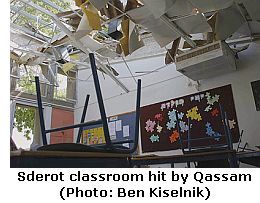 If anyone still doubts the dangers and lethal potential of Qassam missiles, we invite you to view a short video at the Israel Reporter website of a missile strike in Sderot that knocked the videographer Shlomo Rollins to the ground as a Qassam hit a neighbor’s house, injuring a member of the family.
If anyone still doubts the dangers and lethal potential of Qassam missiles, we invite you to view a short video at the Israel Reporter website of a missile strike in Sderot that knocked the videographer Shlomo Rollins to the ground as a Qassam hit a neighbor’s house, injuring a member of the family.
The upsurge in Palestinian factional violence in the Gaza Strip has made international headlines. In the midst of the battles taking place between Hamas and Fatah terrorists, over 30 Qassam missiles have been fired with intent at the residents of Sderot in a 24 hour period and continue to fall even as we write. This, despite Israel’s 2005 withdrawal from Gaza and Palestinian claims to be adhering to a “ceasefire”. Residents have been injured and schools and private homes struck, causing panic and fear in the town’s streets and the closure of schools. The situation has deteriorated to such an extent that a partial evacuation of the most vulnerable residents has begun.
No country in the world can tolerate this sort of bombardment of its civilian population and Israel has, so far, in the face of intense domestic pressure, acted with great restraint, launching limited retaliatory strikes against the terrorists responsible for the Qassam attacks. A wider military operation may yet materialize. Media outlets have been quick to cover these Israeli measures. Yet, many have simply buried the story of Sderot and the context behind Israel’s military response. Far fewer have managed to give this issue the justice that it deserves.
Credit to the Associated Press for running a detailed report from Sderot, which has been picked up by the online versions of the Washington Post, New York Times and Guardian, amongst others, though not necessarily in the print editions – a poor substitute for full coverage. The AP wire service is available to all of the international media. So why haven’t they all used it in the absence of their own journalists visiting the scene? With Gaza a no-go area for journalists since the kidnapping of the BBC’s Alan Johnston, there is even less excuse for reporters on the ground not to visit Sderot, which, despite the Qassams, is still freely accessible.
We make no apologies for once again raising the issue of the media’s scant coverage of Qassam attacks on Sderot. Why is this important? Because, without this proper context and the story of Sderot’s suffering, any Israeli reaction that makes front page news, will wrongly imply that Israel is the aggressor despite the obvious need to take self-defensive measures.
Make sure your local media is doing justice to the tragedy that is taking place in Sderot – if you cannot find adequate coverage, send an e-mail asking why this is the case. Details of many media outlets can be found on our website.
JERUSALEM – THE REALITY
May 16 marked Jerusalem Day, commemorating the reunification of the city under Israeli control in 1967. Right on cue, the NY Times published a confidential document from the International Committee of the Red Cross, which accused Israel of
“a “general disregard” for “its obligations under international humanitarian law – and the law of occupation in particular.”
The committee, which does not accept Israel’s annexation of East Jerusalem, says Israel is using its rights as an occupying power under international law “in order to further its own interests or those of its own population to the detriment of the population of the occupied territory.”
Contrast this with Khaled Abu Toameh’s report the day before in the Jerusalem Post:
“Although different services provided by the state to the Arab residents continue to be relatively insufficient, there is no ignoring the fact that Israeli institutions remain the largest employer of Arab Jerusalemites….
As holders of Israeli ID cards, the Arab residents of Jerusalem receive higher salaries and are entitled to most privileges, including National Insurance payments. The Arabs of Jerusalem are free to work in any part of the country and are not subjected to any restrictions….
“Let’s be honest, we have lost the battle for Jerusalem,” admitted a Fatah legislator from the city. “The Palestinian Authority hasn’t done anything to preserve the Arab and Islamic character of Jerusalem. The Arabs in Jerusalem have lost confidence in the Palestinian leadership and that’s why most of them prefer to live under Israeli control. Frankly, when I see what’s happening in the West Bank and Gaza Strip, I can understand why.”

